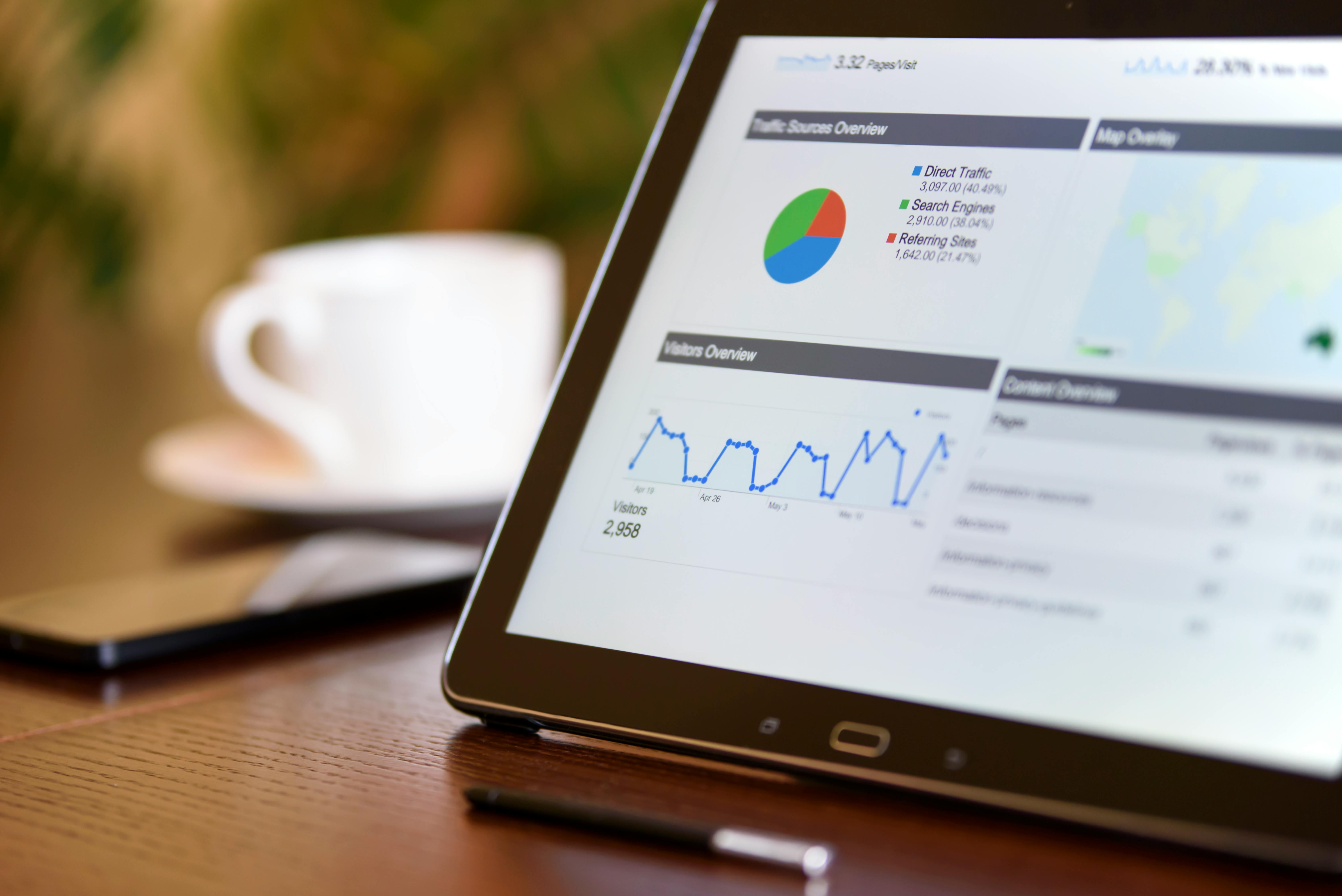How to Build Custom GA4 Dashboards for Better Insights
Are you making the most of your Google Analytics? Custom dashboards in GA4 clarify your data, helping you spot trends, track KPIs, and solve problems faster. With Google Analytics shifting to GA4’s event-based tracking, retail, media, and healthcare businesses can tailor their insights like never before. Whether you’re managing campaigns or monitoring user flow, these dashboards can transform how you strategize and act. Ready to see how they work?
Learn how to create GA4 dashboards here.
Understanding Google Analytics Dashboards
Google Analytics dashboards are the beating heart of data tracking, offering a visual glimpse into your website’s performance. Whether you’re new to analytics or a seasoned expert, understanding dashboards is vital for accurate reporting and decision-making.
What is a Google Analytics Dashboard?
A Google Analytics dashboard is a collection of widgets that summarize your website’s performance metrics in one view. Think of it as your data command center—it’s where vital information converges for quick analysis. Dashboards simplify complex data into digestible chunks, helping you track website traffic, user behavior, and campaign results.
By displaying real-time insights alongside historical trends, they can prompt action faster. Picture this: instead of sifting through endless reports, your top data points are right before you, ready to inform your next move.
GA4 dashboards are now more powerful, thanks to features like event-based tracking, predictive metrics, and cross-platform insights. They can even combine data from mobile apps, websites, and offline sources, giving you the full picture.

Photo by Oleksandr P
Default Dashboards vs. Custom Dashboards
Default dashboards in Google Analytics are a great starting point, but they come with limitations. They’re pre-built and may not align with your unique needs. For instance, if you’re in healthcare, tracking patient flow may differ significantly from analyzing cart abandonment in retail. These dashboards often offer generic KPIs, which might not give you the granular insights you need to act effectively.
So why build a custom dashboard?
Here’s what you gain with customization:
- Tailored Metrics: Focus only on metrics that matter to your business, eliminating unnecessary clutter.
- Industry-Specific Insights: Retailers can monitor checkout funnels, while publishers might prioritize page views and engagement metrics.
- Improved Efficiency: Save time by creating a dashboard that pulls in exactly what you check daily or weekly.
- Multi-Source Integration: GA4 can integrate data from other tools, such as BigQuery or Looker Studio, to create advanced analytics workflows.
Here’s an analogy: consider the default dashboard like a prepackaged salad. It’s good, but what if you want extra spinach or no croutons? A custom dashboard lets you make exactly the salad you want—every ingredient tailored to your taste.
Default dashboards may struggle with scalability. For example, they often lack the flexibility to adjust for large datasets or specific queries. Custom dashboards, however, empower you to go deeper, strengthen reporting accuracy, and cater directly to stakeholders’ concerns.
By leveraging GA4 dashboards to their full potential, you’ll unlock advanced strategies for optimizing campaigns and user experience.
Setting Up Your First Custom Dashboard in GA4
Creating your first custom dashboard in Google Analytics 4 (GA4) might seem daunting, but it’s easier than you think. Custom dashboards help streamline your data analysis, allowing you to focus on the metrics that matter most to your business. Let’s walk through the process step by step, starting with accessing the dashboard interface.
Accessing the Dashboard Interface
To begin, you’ll need to know where to find the dashboard section within GA4. This section is tucked away in a few clicks, but it’s straightforward once you know the path.
- Log into Google Analytics 4: Head to Google Analytics and sign in with your account.
- Navigate to the “Reports” Section: On the left-hand menu, click on “Reports”. This is where the default dashboard and other reporting tools live.
- Locate the Library: At the bottom of the Reports page, you’ll see an option labeled “Library”. This is your gateway to creating and managing dashboards.
- Select “Create New Report.” In the Library, you’ll find an option to start building new custom reports. This is where you’ll set up your personalized dashboard.
GA4’s interface can feel different if you’re transitioning from Universal Analytics, but this streamlined setup ensures all your tools are in one place.

Creating a New Dashboard
Once you’ve accessed the dashboard interface, it’s time to create and customize your new dashboard. Here’s how you can do it:
- Start with a Blank Slate or a Template:
- GA4 offers the option to begin with a blank canvas or to choose pre-set dashboard templates that align with common reporting needs.
- Click “Create New Dashboard” to get started.
- Name Your Dashboard:
- Give your dashboard a descriptive name that reflects its purpose (e.g., “E-commerce Metrics,” “SEO Performance,” or “User Behavior Overview”). This makes it easier to locate and manage later.
- Select Widget Types:
- GA4 dashboards let you add widgets to display your key metrics. Popular widgets include line charts, pie charts, and tables.
- Add widgets that align with your goals. For example, use a line chart to track user sessions or a table to list your top-performing pages.
- Adjust Dashboard Layout:
- Drag and drop widgets to arrange them in a way that’s visually appealing and functional.
- Group related metrics together for clarity. For example, group acquisition data (traffic sources) should be in one section, and engagement metrics (average session duration, time on page) should be elsewhere.
- Customize Filters:
- Filters allow you to narrow down data by specific dimensions like country, device type, or campaign.
- Applying filters ensures your dashboard displays only the most relevant data.
- Save Your Dashboard:
- Once you’re happy with the layout and data, click “Save.” You can always revisit and edit your dashboard as your needs change.
By following these steps, you create a centralized hub for tracking the data that matters most to your business. Think of it as setting up your control room—everything you need is now a glance away!
Adding and Configuring Widgets
Widgets are the essential building blocks of Google Analytics dashboards – they turn raw data into actionable insight. Adding the right widgets is like equipping a toolbox; choose the tools that align with your goals to get work done efficiently. Understanding the types of widgets available and how to configure them can make your custom dashboards not just functional but powerful.
Types of Widgets Available
When building dashboards in Google Analytics, picking the correct widgets is key. Each widget serves a specific purpose and offers different data visualization methods. Here’s a breakdown of the most commonly used widget types:
- Time Series
Displays trends over time. It tracks daily active users, conversion rates, and session counts. - Pie Charts
It is ideal for showing proportions, like traffic by source or user demographics split by age groups. It is simple and effective for visualizing distribution. - Tables
A structured layout to present multiple metrics side-by-side. Use this widget to compare traffic sources or landing page performance at a glance. - Bar Charts
It helps to compare categories. Want to see which campaigns outperformed others? This widget is perfect for just that. - Maps
Visually represent geographic data. Use it to track user activity or conversions by location. - Scorecards
Prominently displays single key metrics. Great for keeping tabs on vital KPIs like revenue or average session duration.
Choosing widgets specific to your business goals ensures your dashboard performs like a well-oiled machine.

Photo by Artem Podrez
Configuring Widgets for Optimal Insights
Adding widgets is only half the battle. Configuring them effectively determines how much value they provide. Follow these tips to make the most of your widgets:
- Define Relevant Metrics:
Avoid clutter by sticking to the KPIs that matter most. If you’re an eCommerce business, focus on metrics like revenue, cart abandonment rate, or new users. - Apply Filters Strategically:
Do you need to see data from a specific region or campaign? Use filters to drill down to the details, removing unnecessary noise. - Group Data Intelligently:
Structure widgets so related data are grouped together. For example, acquisition widgets can sit beside those tracking user behavior. - Leverage Custom Dimensions and Metrics:
GA4 allows custom inputs, letting you tailor widgets to track unique aspects of your business. Configure widgets to display these where they matter. - Test Visual Formats:
Each data set can shine in a different format. Experiment with visualizations—switch between a bar chart and a pie chart for a better view. - Monitor Widget Interactivity:
Widgets can often interact with each other. A filter applied to one widget can impact others. Test this feature to align your insights across the dashboard.
Thoughtful configuration transforms your widgets into meaningful insights, helping you make better decisions faster. Would you rather sort through rows of Excel data or glance at an interactive dashboard showing precisely what you need? Proper widget setup ensures the latter.
Incorporating Advanced Features in GA4 Dashboards
Incorporating advanced features into GA4 dashboards isn’t just about showcasing data—it’s about unlocking a deeper understanding of user interactions and forecasting future trends. From sophisticated event tracking to predictive analytics and cross-platform integrations, these features push dashboards beyond basic reporting into actionable tools that drive business decisions.
Event-Based Tracking in GA4
Event-based tracking is at the core of GA4’s functionality, replacing Universal Analytics’ session-based model. This shift focuses on specific user actions, such as button clicks, video plays, or file downloads, rather than summarizing events under broader sessions. Event-based tracking allows you to gather granular data about user behavior, enabling more detailed and flexible analysis.
The benefits? A clearer picture of the customer journey. For instance:
- Track Key Interactions: Set up events to monitor specific actions, like when users sign up for a newsletter or add items to a cart.
- Better Customization: Build tailored dashboards highlighting business-critical events such as form submissions or page scrolls.
- Improved Accuracy: Since events aren’t tied to sessions, you avoid data loss caused by session timeouts.
By integrating event-based tracking into your custom dashboards, you’re not just seeing what users do; you’re capturing the why behind their behavior, which is essential for refining strategies.
Utilizing Predictive Metrics
Predictive metrics elevate dashboards by forecasting trends, helping you stay ahead of the curve. Powered by GA4’s machine learning capabilities, these metrics anticipate user behavior based on existing patterns in your data.
Here are the key predictive metrics GA4 offers:
- Purchase Probability: Identifies users likely to make a purchase in the next seven days.
- Churn Probability: Pinpoints users who are at risk of disengaging.
- Revenue Prediction: Estimates the revenue that a specific user or audience segment is predicted to generate.
How can these enhance your dashboards? Imagine running an eCommerce website. With predictive metrics:
- You can tailor marketing campaigns toward high-purchase-probability users while re-engaging those at risk of churn.
- Pair this feature with filters and widgets to segment these audiences directly within your dashboard.
This isn’t just reporting data—it’s about enabling action before the trends fully occur.
Cross-Platform Data Integration
Your audience doesn’t stick to one platform, and neither should your analytics. GA4 facilitates cross-platform data integration, merging data collected from websites, mobile apps, and even offline sources. This feature paints a cohesive picture of your user’s journey across multiple touchpoints.
Integrating cross-platform data can:
- Simplify Reporting: See web and app interactions side by side in one dashboard.
- Enhance Attribution Models: Get better insights into which channels genuinely drive conversions.
- Enable Unified Metrics: Combine data sources to provide a more holistic view of KPIs, such as total user engagement or cross-device purchase paths.
For example, if you’re a retailer with both a website and a mobile app, combining these datasets helps you identify trends like app usage driving web purchases. This feature becomes even more powerful when integrated with tools like BigQuery or Looker Studio for further analysis.

Photo by I’m Zion
By incorporating these advanced features into GA4 dashboards, you’re not just refining how you view data but ensuring the insights you gather are actionable, scalable, and future-ready.
Case Studies: Industry-Specific Dashboard Examples
Custom dashboards in Google Analytics 4 (GA4) are powerful tools tailored to meet the unique demands of different industries. By focusing on specific goals and metrics, these dashboards provide actionable insights for businesses, saving time and driving better decisions. Let’s examine examples from the retail, media, and healthcare industries.
Retail Industry Dashboard
Retail businesses prioritize metrics that directly impact revenue and customer satisfaction. A well-designed retail dashboard should emphasize sales performance, marketing ROI, and customer journeys.
Key components of a retail GA4 dashboard might include:
- Conversion Rates: Track how many users are completing purchases.
- Cart Abandonment Rates: Identify potential friction points in the checkout process.
- Traffic by Source: Understand which channels (organic, ads, email) drive the most qualified traffic.
- Revenue by Product Category: Highlight the top-performing products or categories.
For instance, you could configure your dashboard to display a time series widget that tracks revenue trends over time or a map widget to visualize purchase activity by geographic region. Retailers focusing on omnichannel strategies might also incorporate cross-platform data to compare app versus web sales performance.
Media Industry Dashboard
Media companies thrive on keeping their audience engaged. Dashboards tailored for this industry often focus on content performance, audience retention, and engagement metrics.
Components of a media-focused GA4 dashboard may include:
- Page Views and Average Time on Page: Evaluate which articles or videos attract the audience.
- New vs. Returning Visitors: Understand audience loyalty trends.
- Engagement Rates: Dive into metrics like scroll depth or video completion rates.
- Traffic by Device: Optimize content experiences based on mobile vs. desktop use.
A digital publication’s dashboard might include bar charts comparing different articles by engagement, paired with scorecards showing total monthly users or subscription conversions. By identifying high-performing content, media companies can refine their editorial strategies to align with audience interests.
Healthcare Industry Dashboard
In healthcare, data tracking goes beyond business metrics—it’s about improving patient engagement and outcomes. Dashboards enable healthcare organizations to monitor patient journeys, operational efficiency, and engagement touchpoints.
Specific metrics for a healthcare GA4 dashboard might include:
- Appointment Conversions: How many users schedule appointments online?
- Telehealth Session Participation: Identify trends in virtual healthcare accessibility.
- Information Page Views: Understand which healthcare topics resonate most with users.
- Referral Sources: Track which campaigns or websites drive the most traffic to medical services.
Healthcare dashboards should be designed to prioritize HIPAA compliance. A table widget could break down telehealth metrics by time of day while filtering segment data by age or location to see how different populations interact with digital services.
By focusing on these tailored dashboards, industries unlock GA4’s full potential, turning raw data into meaningful insights that align with their goals.
Troubleshooting Common Dashboard Issues
Working with Google Analytics dashboards can be rewarding, but it’s not always smooth sailing. Challenges like data sampling, mismatched metrics, or widget errors can throw you off course. Let’s tackle these issues head-on with practical solutions.
Dealing with Data Sampling
Data sampling is a common issue in Google Analytics, especially when working with large data sets. It’s when Google only analyzes a subset of your total data to generate reports. While sampling can speed up processing, it can also distort your insights.
Here’s how to minimize or avoid data sampling:
- Use Default Reports Instead of Explorations:
Google minimizes sampling in standard reports. If sampling persists, stick to these for high-level insights. - Shorten Your Date Range:
Sampling increases with larger date ranges. Reducing the time frame (e.g., analyzing a week instead of a month) often resolves the issue. - Simplify Custom Reports:
Overly complex queries with many dimensions or filters can trigger sampling. Streamline your report design when possible. - Export Raw Data with BigQuery:
GA4 integrates with BigQuery, allowing you to bypass sampling entirely by exporting your data there. This is ideal for advanced users managing massive data sets. - Upgrade to GA4 360:
The enterprise GA4 plan (GA4 360) offers higher sampling thresholds. It can handle larger datasets without sampling for many queries.
Being mindful of sampling ensures you’re not interpreting incomplete insights. After all, would you prefer a blurry photo or a crystal-clear one?
Fixing Mismatched Metrics
Seeing conflicting data in your reports? Mismatched metrics are more common than you’d think. They happen when different dashboards or widgets display numbers that don’t align.
Why does this happen?
- Different Attribution Models:
GA4 offers various attribution models (e.g., last click, data-driven). Ensure your widgets use the same model across reports. - Conflicting Time Zones:
Time zone settings affect how metrics are calculated. Double-check that your account and properties share the same time zone. - Delayed Data Processing:
Some metrics take longer to update. For example, transaction data may show discrepancies if the report was generated too quickly.
To fix mismatched metrics:
- Use the same filters, dimensions, and date ranges when comparing data.
- Verify attribution models for consistency.
- Align primary time zone settings in property settings.
- Cross-check against raw data exports or other verified sources when in doubt.
Aligning these settings ensures your reports tell the same story, eliminating confusion.
Resolving Widget Errors
Widgets are the building blocks of your dashboards, and when they fail, it’s frustrating. Common widget errors include data not loading, misaligned filters, or broken visualizations.
Here’s how to troubleshoot:
- Refresh Your Data:
Sometimes, errors occur due to a temporary glitch in fetching data. Hit the refresh button to reload. - Check Filters and Dimensions:
If your widget isn’t showing data, the selected filters or dimensions might not match the dataset. Try clearing filters or selecting broader parameters. - Test the Widget Type:
Certain data works better with specific visualization types. For example, a pie chart may not display if your data has too many unique values. - Ensure Compatibility:
If combining data from multiple sources, make sure the data schema aligns. Misaligned metrics or dimensions can cause errors. - Update Browser or Clear Cache:
Browser issues can sometimes interfere with dashboards. Clearing cookies or updating to the latest browser version often resolves minor glitches. - Rebuild the Widget:
When all else fails, delete the problematic widget and replace it. A fresh setup resolves most errors.

Photo by Negative Space
Taking the time to fine-tune your widgets ensures your dashboards run smoothly and deliver the insights you need when you need them. If widgets were tools, these fixes would be like sharpening a blade: They ensure precision and efficiency.
Best Practices for Custom Dashboard Optimization
Custom dashboards in Google Analytics are like a plane’s control panel—they provide all the critical metrics you need to navigate your business’s complexities. Setting them up is one thing, but optimizing them is another. Proper setup and ongoing improvements ensure your dashboard provides accurate, actionable insights without wasting time.
Regularly Update and Review Dashboards
Dashboards are not “set it and forget it” tools. Your business goals, marketing strategies, and audience behaviors evolve over time, and your dashboard should reflect these changes.
- Review Key Metrics Periodically: Are the metrics on your dashboard still aligned with your business goals? For instance, a metric like “bounce rate” might lose relevance when transitioning to engagement-focused strategies in GA4.
- Remove Redundancies: Eliminate outdated widgets or metrics that no longer support decision-making.
- Incorporate New Features: Google Analytics frequently updates features. Stay informed about additions such as predictive metrics or new widget types, and incorporate them into your dashboard.
Just as a car’s dashboard gets updated with new tech, your analytics dashboard should reflect current goals and technological capabilities.
Automating Reporting Workflows
Time is a finite resource, and automation is the key to managing it efficiently. Google Analytics allows you to automate many reporting workflows to save time and ensure consistent data monitoring.
Steps to set up automated reporting in GA4:
- Schedule Email Reports: You can schedule automated email reports to be sent to specific stakeholders daily, weekly, or monthly. This reduces manual effort and keeps everyone informed.
- Use Tools Like Looker Studio: Integrate GA4 with Looker Studio (formerly Data Studio) for seamless, automated dashboards that refresh with the latest data.
- Enable Notifications for Key Metrics: Set up alerts for unusual spikes or drops in performance metrics like website traffic or conversion rates. This will allow you to act faster when anomalies occur.
By automating repetitive tasks, you free your team to focus on deeper analysis rather than routine reporting. Think of it like relying on cruise control for long drives so you can focus on the map—the bigger picture.
Combining Dashboards with Other Tools
A GA4 dashboard is powerful, but integrating it with external tools can unlock even greater potential. Whether it’s enriching your data with external datasets or presenting it through enhanced visualizations, combining tools provides deeper insights.
- BigQuery Integration: Export your data to BigQuery for advanced analyses. This setup is especially useful for businesses with massive datasets requiring SQL queries.
- Looker Studio (Data Studio): Harness this tool for professional, polished reporting. GA4, combined with Looker Studio, enables you to create interactive, dynamic dashboards tailored precisely to your audience.
- Other Marketing Platforms: Merge data from advertising tools like Google Ads or CRM platforms to build a unified view of customer activity across channels.
For instance, a retailer could combine GA4 data with inventory and sales data in BigQuery to analyze how online traffic affects in-store purchases. It’s like upgrading a simple compass to a GPS—better tools lead to better navigation.

Optimizing your custom dashboards ensures they grow alongside your business needs, providing the insights to make smarter decisions quickly.
Conclusion
Custom dashboards in Google Analytics 4 (GA4) are game-changers for businesses striving for deeper insights and smarter strategies. Creating, customizing, and refining dashboards allows for more precise tracking of KPI trends, user behavior, and campaign success. These dashboards are more than just data displays—they’re decision-making tools tailored to your specific needs.
Why Custom Dashboards Matter
Custom dashboards focus on what’s important, cutting through the clutter of generic reports. They allow you to:
- Display metrics that align with your business goals.
- Apply industry-specific insights to retail, healthcare, media, and beyond.
- Incorporate advanced features like event-based tracking, predictive metrics, and cross-platform integration.
Want to track real-time sales conversion during a campaign? Or measure content performance against engagement goals? Custom dashboards let you bring those scenarios to life with precision.
A Continued Investment
The learning curve with GA4 and custom dashboards might seem steep, but the payoff is worthwhile. As Google Analytics continues to evolve with updates like advanced filters and anomaly detection, your dashboards will need periodic reviews and updates. This ensures that your analytics efforts remain cutting-edge and actionable in an ever-changing digital world.

Photo by Lukas
Staying proactive with dashboard optimization and ensuring you’re leveraging the latest features will keep your analytics meaningful and directly tied to your success.






